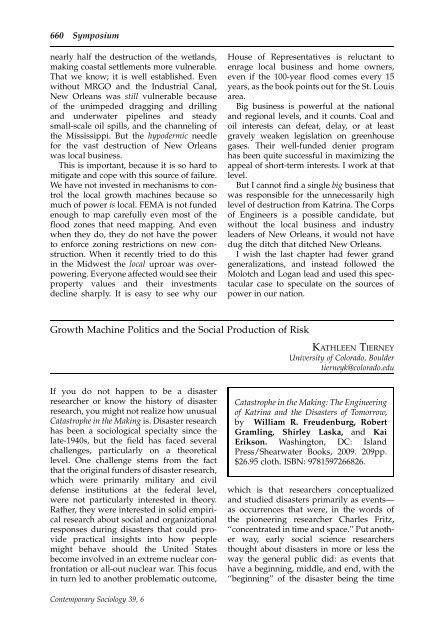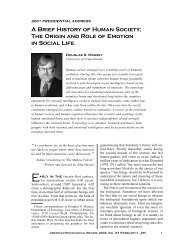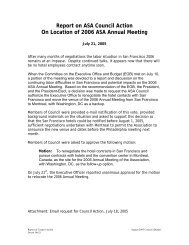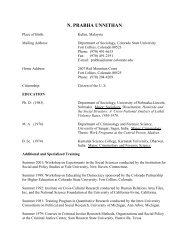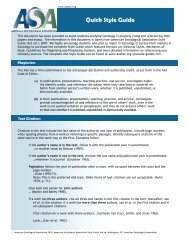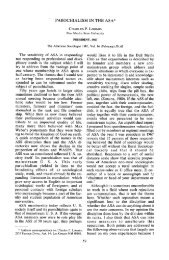Contemporary Sociology - American Sociological Association
Contemporary Sociology - American Sociological Association
Contemporary Sociology - American Sociological Association
You also want an ePaper? Increase the reach of your titles
YUMPU automatically turns print PDFs into web optimized ePapers that Google loves.
660 Symposium<br />
nearly half the destruction of the wetlands,<br />
making coastal settlements more vulnerable.<br />
That we know; it is well established. Even<br />
without MRGO and the Industrial Canal,<br />
New Orleans was still vulnerable because<br />
of the unimpeded dragging and drilling<br />
and underwater pipelines and steady<br />
small-scale oil spills, and the channeling of<br />
the Mississippi. But the hypodermic needle<br />
for the vast destruction of New Orleans<br />
was local business.<br />
This is important, because it is so hard to<br />
mitigate and cope with this source of failure.<br />
We have not invested in mechanisms to control<br />
the local growth machines because so<br />
much of power is local. FEMA is not funded<br />
enough to map carefully even most of the<br />
flood zones that need mapping. And even<br />
when they do, they do not have the power<br />
to enforce zoning restrictions on new construction.<br />
When it recently tried to do this<br />
in the Midwest the local uproar was overpowering.<br />
Everyone affected would see their<br />
property values and their investments<br />
decline sharply. It is easy to see why our<br />
Growth Machine Politics and the Social Production of Risk<br />
If you do not happen to be a disaster<br />
researcher or know the history of disaster<br />
research, you might not realize how unusual<br />
Catastrophe in the Making is. Disaster research<br />
has been a sociological specialty since the<br />
late-1940s, but the field has faced several<br />
challenges, particularly on a theoretical<br />
level. One challenge stems from the fact<br />
that the original funders of disaster research,<br />
which were primarily military and civil<br />
defense institutions at the federal level,<br />
were not particularly interested in theory.<br />
Rather, they were interested in solid empirical<br />
research about social and organizational<br />
responses during disasters that could provide<br />
practical insights into how people<br />
might behave should the United States<br />
become involved in an extreme nuclear confrontation<br />
or all-out nuclear war. This focus<br />
in turn led to another problematic outcome,<br />
<strong>Contemporary</strong> <strong>Sociology</strong> 39, 6<br />
House of Representatives is reluctant to<br />
enrage local business and home owners,<br />
even if the 100-year flood comes every 15<br />
years, as the book points out for the St. Louis<br />
area.<br />
Big business is powerful at the national<br />
and regional levels, and it counts. Coal and<br />
oil interests can defeat, delay, or at least<br />
gravely weaken legislation on greenhouse<br />
gases. Their well-funded denier program<br />
has been quite successful in maximizing the<br />
appeal of short-term interests. I work at that<br />
level.<br />
But I cannot find a single big business that<br />
was responsible for the unnecessarily high<br />
level of destruction from Katrina. The Corps<br />
of Engineers is a possible candidate, but<br />
without the local business and industry<br />
leaders of New Orleans, it would not have<br />
dug the ditch that ditched New Orleans.<br />
I wish the last chapter had fewer grand<br />
generalizations, and instead followed the<br />
Molotch and Logan lead and used this spectacular<br />
case to speculate on the sources of<br />
power in our nation.<br />
KATHLEEN TIERNEY<br />
University of Colorado, Boulder<br />
tierneyk@colorado.edu<br />
Catastrophe in the Making: The Engineering<br />
of Katrina and the Disasters of Tomorrow,<br />
by William R. Freudenburg, Robert<br />
Gramling, Shirley Laska, and Kai<br />
Erikson. Washington, DC: Island<br />
Press/Shearwater Books, 2009. 209pp.<br />
$26.95 cloth. ISBN: 9781597266826.<br />
which is that researchers conceptualized<br />
and studied disasters primarily as events—<br />
as occurrences that were, in the words of<br />
the pioneering researcher Charles Fritz,<br />
‘‘concentrated in time and space.’’ Put another<br />
way, early social science researchers<br />
thought about disasters in more or less the<br />
way the general public did: as events that<br />
have a beginning, middle, and end, with the<br />
‘‘beginning’’ of the disaster being the time


